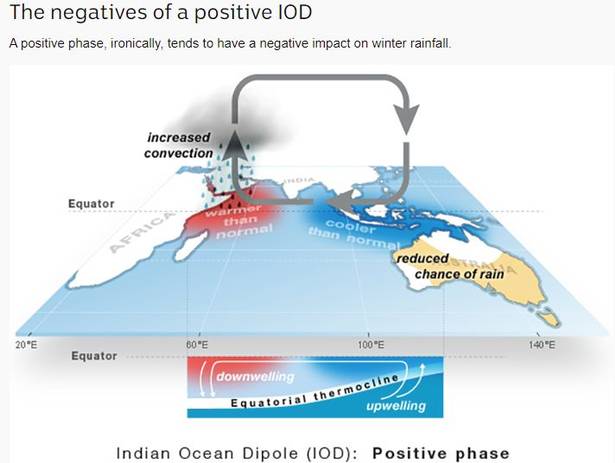Why in
news?
Bushfires in Australia have razed more than 10.3 million hectares (103,300 sq km) of land — roughly the size of South Korea — since September. It may be an implication of Indian Ocean Diploe (IOD).
Why did Australia suffer from drought?
- Playing out to the north and south of the equator, the progression of monsoon winds more or less corresponds to the natural occurrence of troughs and ridges in the same pressure field
- Every trough is matched by a crest somewhere — troughs represent areas of low pressure featuring ascending motion of air and its cooling, clouds and rain while ridges mean the reverse: high pressure from descending motion of air, dryness, heat, no clouds or rain.
- Climate models had indicated that the positive IOD may persist longer than typical events do — active right from May 2019 before peaking in October-November and decaying only during the first week of January 2020.
- In this manner, a positive IOD that persisted longer than usual is thought to have contributed to a delay in transition of the monsoon trough from the Northern Hemisphere to the Southern Hemisphere and onset of the Australian monsoon
- The IOD breakdown occurs when the monsoon trough moves into the southern hemisphere in early December (this is when the North-east monsoon in India draws to a close).
What followed the delay of rain?
The persistent heat and drought buttressed by the positive IOD conditions may have acted as a perfect foil for the tinder-like conditions, with climate change scientists and naysayers pitched on either side of a towering inferno, arguing their respective cases of what might have triggered the devastation.
Is it due to climate change?
In recent years, Australia has experienced longer dry conditions and exceptionally low rainfall. On the other side, climate change naysayers have been quick to point out at other triggers; for instance, one of the strongest IOD events ever on record.
Indian Ocean Dipole (IOD)
- The positive IOD refers to the warmer western basin of the Indian Ocean as compared to the Eastern basin.
- This year (2019), over the past month, strong easterly trade winds across the tropical Indian Ocean have aided the upwelling of cooler water in the eastern Indian Ocean (closer to Australia).
- At the same time, warm waters off the Horn of Africa (West Indian Ocean) have caused an even greater temperature across the basin.

Impact of IOD on Australia
- The impact of a delayed monsoon may have implications for Australian summer crops with the decline in planted area (approx. fall of 28%) in 2019–20.
- Typically, a positive IOD brings below-average winter-spring rainfall to southern and central Australia and a more severe fire season for South-East Australia.
- In the tropical Pacific Ocean, the El-Nino Southern Oscillation (ENSO) remains neutral.
- When ENSO is neutral, it has little effect on Australian and global climate, meaning other influences are more likely to dominate.



